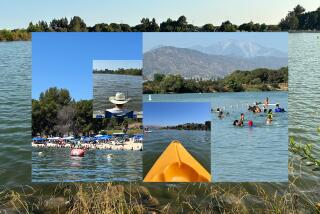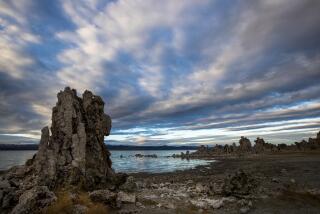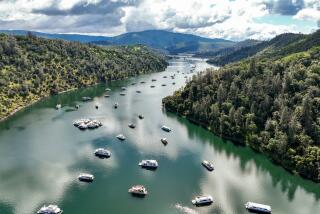Lake Mission Viejo isn’t feeling California drought — yet
- Share via
Lake Mission Viejo is Southern California at its most idyllic and, when it comes to water, its most extravagant. Multimillion-dollar homes surround a 1.2-billion-gallon lake created solely for recreation, where sailboats sway under sunny afternoon skies as children frolic on pristine sandy beaches.
Since its creation in the 1970s — in the middle of a drought — the manufactured lake has become so ingrained in south Orange County’s identity that it is the backdrop to Mission Viejo’s city seal.
Now, almost 40 years after first-term Gov. Jerry Brown chastised officials for filling the lake “while others use buckets to collect water in their showers,” Mission Viejo is under scrutiny again as the state struggles through another relentless drought. In California’s third consecutive drought year, state officials are beginning to consider whether the sparkling waters that are the city’s recreational haven might be better used to fill bathtubs and drinking glasses in the most parched regions.
Private lakes for a few wealthy suburbanites are a vestige of a past ideal, critics say, one that is inappropriate for these dry days.
“You have to hand it to them; [a lake] was a fantastic idea. But today, that water should be available for indoor use, not outdoor recreation,” said Stephanie Pincetl, director of the California Center for Sustainable Communities at UCLA.
The association that owns and operates the lake is quietly discussing with the local water district ways to use less water while keeping the lake filled. But the very presence of the vast watery playground raises questions, experts say, about Californians’ outsized relationship with water.
::
Homes in master-planned Mission Viejo were hot property from the start. For five years, beginning in 1966, Mission Viejo Co. set and broke its own Orange County home sales records as the community grew to a population of 17,500.
Then in 1973, the company announced plans to spend $5.6 million to build a lake with about 3.5 miles of shoreline.
When it came time in 1977 to fill the lake, developers sparked a political firestorm. Amid one of the worst droughts in state history, the company planned to import up to 40% of the lake’s water from Northern California through an aqueduct crossing the Tehachapi Mountains. That did not sit well with some northerners, who, according to news reports, were counting water by the glass.
Even officials in the Southland lambasted the lake project. In a 1977 Times story, a Southern California water department head said he would “withhold any blessing” of it.
Mission Viejo Co. Vice President Harvey Stearn defended the lake, telling The Times there was “no water shortage in Southern California.”
As political pressure mounted, the California Water Board ordered Mission Viejo Co. to stop filling the massive hole it had dug for the lake.
A year later, the drought subsided, the board allowed filling of the lake with water from the Colorado River, and the Lake Mission Viejo Assn. opened with 3,000 members.
Postcards featuring sailboats would soon tell potential home buyers of “The California Promise” they could realize there. Thousands more families rushed at the chance to buy property in lakefront neighborhoods where homes sold for more than $100,000.
::
Today, the lake is part of a “complete, year-round resort,” with beaches, parks, clubhouses and a stage that hosts summer concerts. Association members can rent boats or kayaks, join the yacht club or just go fishing. High-end custom homes along the lake can sell for more than $3 million.
Only association members, who pay more than $200 annually, can access the lake. And only those who live within portions of the city originally developed by the Mission Viejo Co. can be members. The association now includes more than 24,000 households, said spokesman Laer Pearce.
Once again, though, state officials are raising concerns about what Max Gomberg, the State Water Resources Control Board’s scientist, called “nonessential” water uses such as recreational lakes.
After three dry years with no relief in sight, Gov. Brown has asked Californians to reduce their water use by 20%. Some parched communities are living on the verge of waterlessness, trucking in water and praying for rain. And many local water districts, including Santa Margarita Water District, have issued water restrictions that limit lawn irrigation, car washing and water use for construction. If the drought worsens, Gomberg said, private lakes could face restrictions, too.
“When there’s not enough water to meet all the needs, some needs have to be put ahead of others,” he said.
Santa Margarita Water District officials are working with the lake association to find ways to cut back. With 124 surface acres, the lake loses about 88 million gallons of water to evaporation each year — enough to fill more than 130 Olympic-sized swimming pools. The lake association refills it with fresh, potable water, making it one of the district’s largest water users.
Leaders are considering cutbacks in other areas of the resort to offset the lake’s water use, Santa Margarita Water District spokesman Jonathan Volzke said. The association could also help fund projects that would move some large irrigation systems to recycled water, he said.
If the drought worsens, though, the association might not get those options. The Santa Margarita Water District has already implemented Stage 2 water restrictions. Stage 3 would force the association to obtain a permit to replace water lost to evaporation. Stage 4 would ban such filling altogether.
Tampering with the lake’s water can be a touchy subject for some longtime association members, who chafed at the suggestion of reducing or changing the lake levels.
“We love coming down here where there aren’t too many people,” said Carlos Lopez, an association member whose 4-year-old daughter, Dayleen, splashed in the water. “She’s a fish. I’d have to take her down to the beach, and that’s a pain.”
Mission Viejo, state officials said, may be the largest manufactured lake in the Southland that is solely recreational. Statewide there are more than 120 lakes that are primarily used for recreation, though state officials say some also are used to store water supplies.
Conner Everts, co-facilitator of the state’s Environmental Water Caucus, an organization that promotes sustainable water management, said that drought or no, creating a “giant swimming pool for the few” with a public resource “makes no sense at all.”
“We have these inequities across the state, and this exemplifies water abuse,” Everts said. “You want lakes? Move to Minnesota.”
Based on current estimates, it would take years of strict no-fill regulations for Lake Mission Viejo to dry up.
That possibility seemed far from the minds of most lakegoers on a recent afternoon, as sunbathers, swimmers and strollers enjoyed their piece of the “California Promise.”
Priscilla Blanco, 42, supervised as her 5-year-old daughter and 3-year-old son heaved buckets of sand into a massive mound under a lifeguard tower.
Blanco moved to Mission Viejo about a year ago and has been a lake association member for a few months. She brings her children regularly and hadn’t considered whether the lake was the best use of California’s increasingly scarce water.
“It’s really wonderful,” Blanco said. “But I wouldn’t want to hurt anyone else.”
matt.stevens@latimes.com
Twitter: @MattStevensLAT
More to Read
Get the Latinx Files newsletter
Stories that capture the multitudes within the American Latinx community.
You may occasionally receive promotional content from the Los Angeles Times.







